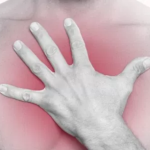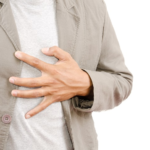Surgery for hiatal hernia
Diaphragmatic hernia is a pathological condition in which there is an exit of the internal organs of the abdominal cavity through holes or weaknesses in the muscular structure of the diaphragm. Surgery for a hernia of the esophageal opening of the diaphragm is prescribed in rare cases, because this disease, with adequate conservative therapy, has a favorable prognosis and does not affect the function of internal organs.
The main reason for the development of weak spots in the diaphragm is a violation of the laying of organs and tissues in embryogenesis, this is how hernias of the congenital type develop. The acquired type occurs as a result of age-related changes and a sedentary lifestyle.
A hernia can occur with increased flatulence, constipation and during pregnancy. All these processes are associated with an increase in pressure in the peritoneal cavity.
Morphologically, a diaphragmatic hernia, like all the others, has a gate, a sac and hernial contents in its structure. In the event that the organs in the formed sac are infringed, their gradual necrosis and inflammation occur, with the further development of complications.
Clinical manifestations
In most patients with diaphragmatic hernia, the main symptoms are associated with reflux of the stomach and esophagus. Characteristic of a hernia is the appearance of pain in the epigastric region and behind the sternum.
The second symptom after reflux is heartburn, which occurs due to the action of an aggressive gastric environment on the mucosa of the esophagus. Patients, as a rule, begin to feel relief after belching. Mucus regurgitation without previous nausea may also occur, the contents being represented by undigested food particles.
Symptomatic manifestations in diaphragmatic hernia in most cases completely depend on which organs are in the bag. Very often, the clinical course of even huge hernias can occur almost asymptomatically and they are accidentally detected during x-ray studies.
Sliding hernial protrusions of the esophageal opening of the diaphragm have a typical clinical course and a rather diverse symptomatology. But in some cases, even such variants of hernias can proceed almost asymptomatically.
Among the complications of sliding hernias of the diaphragm, the most common are gastric and intestinal bleeding, the formation of strictures of the esophagus. The causes of bleeding can be erosive and ulcerative destructive changes in the gastric mucosa, which are located in the area of its compression in the aperture of the diaphragm. Bleeding is not massive and is recurrent.
The most dangerous and formidable complication of hernias of any localization is its infringement, such a pathology can be compared with strangulation intestinal obstruction with a sharp violation of nutrition and oxygenation of parts of the strangulated organs.
Treatment tactics
Conservative therapy is based on the appointment of a special diet and the organization of the correct and comfortable position of the patient. As a medical treatment, drugs are prescribed aimed at inhibiting gastric secretion, neutralizing the action of hydrochloric acid, accelerating the evacuation of contents from the human stomach, and combating constipation.
In more severe cases, patients are shown an operation to remove the hernia of the POD, the surgical intervention is aimed at reducing the hernial sac and strengthening the weak point of the diaphragm.
Operation for HH
X surgical treatment of hiatal hernia is indicated when there is :
- persistent pain syndrome;
- internal bleeding;
- fixation of organs in the area of the hernial ring;
- dysplasia and ulcer of the esophagus;
- sliding paraesophageal hernia;
- infringement of organs in the hernial sac;
- deterioration of the patient's condition during conservative therapy;
- stenosis (narrowing) of the esophageal tube.
The main variant of the operation for HH is the Nissen fundoplication. Its essence lies in fixing a cuff on the upper part of the stomach, which will prevent the contents from being thrown into the esophagus. In addition, during the operation, the surgeon returns the organs to the anatomical site.
Fundoplication state of the esophageal sphincter:
- the motility of the organ is normalized;
- sphincter tone increases;
- the process of emptying returns to normal;
- reduction in the number of contractions.
Open Nissen fundoplication
Surgery for a hernia of the esophagus with open access is done when the patient's condition is severe and immediate surgical intervention is necessary. This technique has disadvantages, especially the disadvantage is that after treatment, the patient has heartburn, a feeling of heaviness and squeezing in the chest area for a long time.
Closed fundoplication or laparoscopy
Laparoscopic surgery to remove a hernia is indicated for planned intervention. The surgeon observes what is happening in the area of the defect on the screen, while he can see the slightest changes in the operated area. Such an operation to remove a hernia reduces the risk of accidental tissue injury, and the possibility of postoperative complications also decreases.
During laparoscopic surgery, the surgeon removes part of the esophagus and stomach and then returns them to their normal anatomical location. After that, crurography is performed, the essence of which is to narrow the esophageal tube to the appropriate size. At the end of the operation, the fundoplication is performed directly, the cuff is placed on the gastric wall.
L aparoscopic surgery for a hernia of the esophagus has several advantages:
- the possibility of restoring the normal anatomy of the abdominal cavity and chest;
- atraumaticity of vessels and nerves;
- quick recovery after surgery , low risk of recurrence of hernia of the esophagus;
- creation of a functioning valve , the presence of which eliminates the need for lifelong medication.
The choice of laparoscopic hernia surgery is possible only with a satisfactory condition of the patient, when there are no acute pathologies of the gastrointestinal tract and the hernia is uncomplicated. After removal, the patient will be able to return to normal life in a few days, following general preventive recommendations.
It is important to understand that a hiatal hernia and an operation to remove it will be equally dangerous if therapeutic and preventive measures are not followed before and after surgery.
Removal of HH with concomitant pathologies
Peptic ulcer, reflux esophagitis, cholelithiasis are frequent companions of esophageal hernia, and they also require surgical treatment. To solve several problems at the same time, laparoscopic surgery is an ideal option. It is indicated when it is necessary to operate on such organs as the stomach, gallbladder, diaphragm and nipple of Vater. An important advantage of laparoscopy in this case will be the speed of execution, the duration of the operation increases by no more than 40 minutes.
Removal of a hernia of the esophagus can be performed simultaneously with cholecystectomy (for calculous cholecystitis) and proximal vagotomy (for duodenal ulcer).
rehabilitation period
After the operation, the patient is prescribed a diet, bed rest is not required. When carrying out laparoscopy in the abdomen, 3 incisions with a length of no more than 1 cm remain. The first day the patient remains in bed and can only drink liquid. From the second day you can eat liquid food, get out of bed, start doing your usual things.
The patient is usually discharged on the 2-3rd day, in rare cases additional monitoring of the condition is required for several more days, but not more than 7 days.
After 2-3 weeks you can return to work. A strict diet after surgery is prescribed for 3-4 weeks, a mild diet continues throughout life.
After removal of HH, there is a risk of the following complications:
- re-development of the disease with the need for a line operation;
- inflammatory process in the area of the surgical scar;
- violation and divergence of the seam;
- painful sensations;
- discomfort during and after eating;
- cuff migration;
- dysphagia (difficulty swallowing certain foods).
A strict diet with the following reduce the risk of consequences :
- fractional meals in small portions;
- strict diet for the first 2 weeks after surgery;
- last meal no later than 3-4 hours before bedtime;
- do not drink any liquid during meals;
- be sure to drink clean water between meals;
- in no case do not overeat and do not rush while eating;
- Eliminate foods that promote gas formation and constipation.
About the general prevention of complications after surgery:
- taking anti-inflammatory drugs, antacids, drugs to improve gastrointestinal motility and inhibit the production of hydrochloric acid;
- adherence to a diet, drinking enough fluids during the day to normalize the water-salt balance;
- breathing exercises, yoga, meditation;
- a full night's sleep and rest in the daytime;
- giving up smoking and drugs that irritate the respiratory tract, provoking frequent coughing.
After surgery to eliminate HH, the patient is contraindicated in heavy physical work.
In the early recovery period, it is recommended not to bend the body forward and be less in a horizontal position, especially after eating. Breathing exercises, outdoor walks, some yoga asanas will be useful after the operation.










